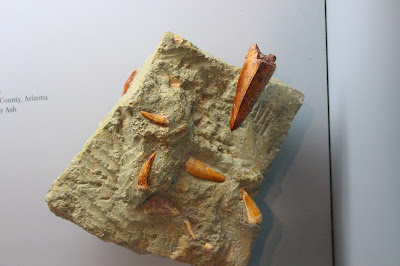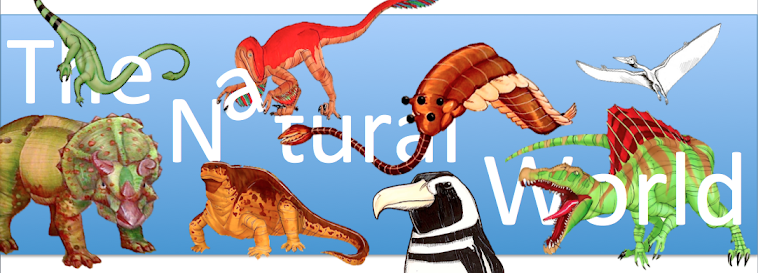At one point in the new
Jurassic World movie, the main character Owen Grady (played by popular actor Andy Dwyer) pulls a broken
tooth from the main monster
Indominus rex from the shell of one of the Gyrospheres. Believe it or not, broken teeth just like this are incredibly important for
paleontologists when it comes to studying many different aspects of
dinosaur habits and behavior! First, let's take a quick look at the anatomy of a dinosaur tooth.
In the picture above, both teeth belong to the famed tyrant
lizard king
Robert California Tyrannosaurus rex itself! The tooth on the top is larger, but it wouldn't have appeared that much larger in the mouth of the animal. The reason behind that is the darker brown part on the left of the tooth is actually the root of the tooth, and would have been inside the animals skull. The tooth underneath, the darker brown one, is a shed tooth crown. Dinosaurs, unlike
mammals, have an infinite supply of teeth, and if they lost a tooth it simply didn't matter! They would grow another one in its place in a few weeks.
 |
| Stan, the Tyrannosaurus rex skull on display at the Morrison Natural History Museum. Look on the upper jaw. See the largest tooth, just about in the middle of the tooth row? Let's zoom in and take an inside look! |
 |
| This is a view from the inside of the Tyrannosaurus skull from above, a view that the lawyer from Jurassic Park probably didn't find quite as fascinating. See the largest tooth in the middle of the picture? Notice how there's another little bump at the top of the tooth row, where the teeth are emerging from the maxilla bone. That's actually another tooth growing in underneath! If we CT scanned the original fossil, you'd be able to see all sorts of teeth growing in underneath! |
 |
| Here we have a dental battery of the famous Triceratops, on display at the Rocky Mountain Dinosaur Resource Center (RMDRC) in Woodland Park, Colorado. Now take a look at the picture below. |
 |
| Here, we have an individual tooth of Triceratops, out of the dental battery that you can see in the picture above. This specimen is from the Hell Creek Formation of South Dakota, and also on display at the RMDRC. |
 |
| The reconstructed jaws of the enormous, sixty foot long shark Megalodon, on display at the Mace Brown Museum of Natural History at the College of Charleston in South Carolina. Like other sharks, as well as dinosaurs, you can see the several rows of teeth in the jaws of this guy, as well as the enormous biceps on the arms of the sexy Chris Pratt look-alike on the right. Biceps for scale are approximately 36 inches in diameter. |
 |
| Here and below, we have pictures of part of the dentary of the large carnivorous theropod dinosaur Torvosaurus from the Late Jurassic Morrison Formation. You can see on the end in the picture above, the tooth is growing in, while the rest of the teeth are pretty well established. This fossil is on display at the University of Colorado Museum of Natural History in Boulder. |
 |
| Another shot of that Torvosaurus dentary seen above, you can see another tooth growing in as well, second from the left. |
Shed teeth can be quite important for paleontologists when it comes to determining behavior of these extinct creatures. When paleontologists discover shed teeth of an animal, it can be a good indicator that the dinosaur was feeding on something nearby. Unfortunately, shed teeth are easily recognized as fossils by most laymen, and are therefore often picked up by the public or fossil collectors looking to make a quick buck, thereby destroying any information we could potentially gain from such knowledge. With good samples of shed teeth, like those employed by paleontologist
Dr. Robert Bakker at the Late Jurassic Morrison Formation site of Como Bluff in
Wyoming, scientists can learn about dinosaur diets, habits, habitats, and behavior, such as group movement, pack hunting, and even whether dinosaurs cared for their young!
 |
| A shed tooth crown of a Tyrannosaurus on display at the RMDRC. |
 |
| A shed tooth of Nanotyrannus, a small cousin of Tyrannosaurus rex, from South Dakota. |
 |
| Leidyosuchus, a type of Cretaceous crocodilian, with several shed teeth. |
 |
| Brachychampsa, another Cretaceous crocodilian. |
In 1877, local geologist
Arthur Lakes discovered the very first bones of the dinosaurs
Stegosaurus armatus and
Apatosaurus ajax in
Morrison, Colorado, and if you check out the
Morrison Natural History Museum, you can actually see them there today! Surrounding the genoholotype of
Apatosaurus ajax, the very first specimen called YPM 1860, was reported by Lakes to have seven shed teeth belonging to an allosaur surrounding the specimen. This indicates some that the predatory allosaurs were actually feeding on the
Apatosaurus, which is very interesting information for paleontologists to have! Below are two pictures of part of that YPM 1860 specimen, with the Director and Chief Curator of the Morrison Natural History Museum
Matthew Mossbrucker pointing to the shed allosaur tooth crown. These pictures are from the collections of the Yale Peabody Museum in Connecticut.
 |
| Shed allosaur tooth crown in the matrix of YPM 1860. Photo Credit: Matthew Mossbrucker |
 |
| Shed allosaur tooth crown in the matrix of YPM 1860. Photo Credit: Matthew Mossbrucker |
|
Non mammals rarely have more than one type of tooth in their mouth, and when they do, it can often be the cause of celebration. For example, in our previous post about the
Latin and Greek root of two, we discussed two animals called
Dimetrodon and
Dimorphodon.
Dimetrodon is an early ancestor of modern mammals, and its name means "two measures of teeth," as it has two different types of teeth in its mouth.
Dimorphodon is a type of
pterosaur (sometimes referred to as pterodactyls), a distant cousin of
Pteranodon, whose name means "two morphs of teeth," again in reference to the fact that two types of teeth are in the animals mouth. The animal below is a dinosaur called
Heterodontosaurus, who belongs to the eponymously named family of dinosaurs, the Heterodontosauridae. As you can see in the picture below,
Heterodontosaurus has several larger teeth in the front of their mouth, and smaller teeth in the back.
 |
| Heterodontosaurus, a small little Early Jurassic dinosaur from South Africa. As you can see, there are two different types of teeth in their mouth, larger ones in the front and smaller ones in the back. |
One of the things that make mammals special is our teeth. One of the most classic features of us mammals is our varied teeth. In us humans, we have our
incisors and
canines in front, and our chewing
molars in the back. Since most mammals were only about the size of a shrew back during the Mesozoic Era, the time of the dinosaurs, in many places such as Como Bluff in Wyoming, paleontologists rely almost exclusively on the teeth of the tiny little mammals, since the teeth are much harder and more durable than the rest of the skeleton. Below, we have a trio of
elephantid molars on display at the Mace Brown Museum of Natural History at the College of Charleston in South Carolina. Look at how varied the teeth are! The first two belong to animals whose teeth were better adapted for crushing and grinding tougher vegetation, while the last molar would have been better for mashing up grasses.
 |
| Cuvieronius tropicus, a Pliocene-aged elephantid from South Carolina. Large, high-cusped molars for crushing and grinding tougher vegetation. |
 |
| Stegomastodon mirificus, a Pliocene and Pleistocene-aged elephantid, discovered in the Ashepoo River of South Carolina. Like Cuvieronius, Stegomastodon also has those large, high-cusped molars that are great for demolishing tough plant matter. |
 |
| The Imperial mammoth (Mammuthus imperator) from the Pleistocene of Florida. These guys have a similar design of tooth to the dental battery of the ceratopsian dinosaurs mentioned above. The duck-billed dinosaurs, or hadrosaurs, also had a similar design. These teeth are broad and flat and good for mashing up grasses. |
Shed teeth can be pretty important when paleontologists study fossils and extinct animals. They are good at establishing behavior, and can be pretty important for long-term studies of paleoenvironments. So when Owen uses the shed Indominus tooth in Jurassic World, believe it or not, that's actually something that paleontologists do from time to time!




















Owen Grady is played by Chris Pratt. Andy Dwyer is another fictional character played by the same actor.
ReplyDelete